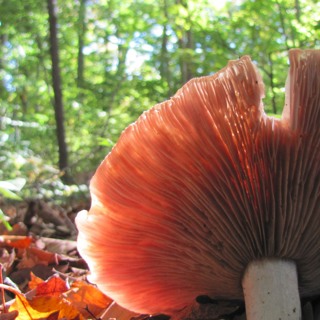
Journal of Applied Ecology: Manging for Climate Change
In this podcast Andrew Suggitt interviews Owen Greenwood about their paper ‘Using in situ management to conserve biodiversity under climate change’ published in the Journal of Applied Ecology - http://onlinelibrary.wiley.com/doi/10.1111/1365-2664.12602/full.
19 Tammi 20163min

FE Making the Most of Microbes with Emma Sayer and Ken Thompson
Emma Sayer and Ken Thompson talk about Emma's virtual issue: Making the Most of Microbes: http://www.functionalecology.org/view/0/virtualIssues/VI_mostofmicrobes.html Microorganisms carry out a large number of fundamental processes that underpin ecosystem function. The enormous diversity and high functional overlap of soil microbes in particular makes this an exciting but challenging area of research in functional ecology. This virtual issue takes a look at some of the advances in ecosystem research made possible by considering microbial processes and populations within the bigger picture of ecosystem function.
8 Tammi 201618min

FE: Alan Knapp Thomas Hasper & Johan Uddling on water use in boreal forests in a changing climate
Thomas Hasper and Johan Uddling talk to FE Editor Alan Knapp about their recent paper "Water use by Swedish boreal forests in a changing climate." The ongoing increases in atmospheric CO2 and temperature have the potential to alter the flux of water vapor through plant leaf ‘stomata’, tiny and actively regulated pores in the leaf surface, but relatively little is known about the water-use responses of boreal forests. In their study, the authors examined the water-use responses of Swedish boreal forests to climate change by using long-term monitoring as well as experimental data. They used climate and runoff data of large-scale boreal landscapes from the past 50 years to explore historical trends and patterns, as well as we examining explicit tree water-use responses to elevated [CO2] and/or air temperature in a whole-tree chamber experiment using mature Norway spruce trees. Their findings have important implications for projections of the future hydrology of European boreal coniferous forests, indicating that changes in precipitation and standing biomass are more important than effects of elevated [CO2] or temperature on tree transpiration rates. Hasper, T. B., Wallin, G., Lamba, S., Hall, M., Jaramillo, F., Laudon, H., Linder, S., Medhurst, J. L., Räntfors, M., Sigurdsson, B. D. and Uddling, J. (2015), Water use by Swedish boreal forests in a changing climate. Funct Ecol. doi:10.1111/1365-2435.12546 http://onlinelibrary.wiley.com/doi/10.1111/1365-2435.12546/abstract
23 Marras 201512min

JEC: David Gibson interviews Scott Collins
JEC: David Gibson interviews Scott Collins by British Ecological Society
11 Marras 201513min

JEC: David Gibson interviews Carol Thornber
Executive Editor, David Gibson, interviewed Carol Thornber at ESA 2015 about all things aquatic ecology.
16 Loka 201520min

FE: Amy Hahs & Robbie Wilson on using urban ecosystems to expand fundamental ecological knowledge
Robbie Wilson talks to Amy Hahs about using urban ecosystems to expand fundamental ecological knowledge. Amy Hahs guest-edited our latest Special Feature: Ecology of Organisms in Urban Environments with Karl Evans. You can read the Special Feature here: http://www.functionalecology.org/view/0/specialfeatures.html#urbaneco
3 Syys 201514min

FE Alan Knapp talks to Isabelle Marechaux on predicting drought tolerance for Amazonian forest trees
Droughts are predicted to become increasingly frequent and intense in Amazonia, and empirical evidence for the vulnerability of Amazonian trees to drought has grown over the past decade. Little is known, however, about the mechanisms or the diversity of drought tolerance in tropical trees and, it has been difficult to quantify drought tolerance in tropical trees, due to a lack of consensus on a relevant tree functional trait, practical to measure for the hundreds of tree species occurring in tropical forests. In this study, Isabelle Marechaux and her co-authors looked at leaf water potential at wilting or turgor loss point (πtlp), which determines tolerance of leaves to drought stress. By using a new method based on a demonstrated association between πtlp and another trait, the leaf osmotic water potential at full hydration, they were able to estimate πtlp for 165 trees of 71 species, at three sites within forests in French Guiana. This dataset represents a significant increase in information for tropical tree species, revealing a wider range of drought tolerance than previously found in the literature and indicating a potential for highly diverse species responses to drought within forest communities. Given the weak correlations between πtlp and traditionally measured plant functional traits, vegetation models seeking to predict forest response to drought should integrate improved quantification of comparative drought tolerance among tree species.
29 Kesä 20158min

FE: Community phylogenetics and ecosystem functioning with Anita Narwani and Patrick Venail
Alan Knapp talks to Anita Narwani and Patrick Venail about their new Extended Spotlight: Community Phylogenetics and Ecosystem Functioning: http://j.mp/FE29I5
15 Kesä 201515min





















